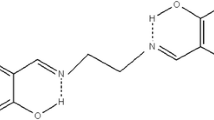Summary
Base hydrolysis of methyl ethylenediaminemonoacetate has been studied at I=0.1 mol dm−3 (NaClO4) over the pH range 7.4–8.8 at 25 °C. The proton equilibria of the ligand can be represented by the equations,
where E is the free unprotonated ester species. Values of pK1 and pK2 are 4.69 andca. 7.5 at 25° (I=0.1 mol dm−3). For base hydrolysis of EH+, kOH=1.1×103 dm3 mol−1 s−1 at 25 °C. The species E is shown to undergo lactamisation to give 2-oxopiperazine (klact ca. 1×10−3 s−1) at 25 °C. Formation of the lactam is indicated both by u.v. measurements and by isolation and characterisation of the compound.
Base hydrolysis of the ester ligand in the complex [CuE]2+ has been studied over a range of pH and temperature, k 25OH =9.3×104 dm3 mol−1 s−1 with ΔH≠=107 kJ mol−1 and ΔS ≠298 =209 JK−1 mol−1. Base hydrolysis of [CuE]2+ is estimated to be some 1055 fold faster than that of the free ester ligand. The results suggest that base hydrolysis occursvia a chelate ester species in which the methoxycarbonyl group of the ligand is bonded to copper(II).
Similar content being viewed by others
References
R. W. Hay and P. J. Morris in H. Sigal (Ed.),Metal Ions in Biological Systems, Vol. 5, Marcel Dekker, New York 1976.
N. E. Dixon and A. M. Sargeson in T. G. Spiro (Ed.),Zinc Enzymes, Wiley, New York, 1983.
D. A. Buckingham in A. W. Addison, W. R. Cullen, D. Dolphin and B. R. James (Eds.),Biological Aspects of Inorganic Chemistry, Wiley-Interscience, New York, 1977.
H. Kroll,J. Am. Chem. Soc., 74, 2036 (1952).
M. L. Bender and B. W. Turnquest,J. Am. Chem. Soc., 79, 1889 (1957).
H. L. Conley and R. B. Martin,J. Phys. Chem. 69, 2914 (1965).
J. E. Hix and M. M. Jones,Inorg. Chem. 5, 1863 (1966).
C. Regardh,Acta Pharm. Suec., 3, 101 (1966).
R. W. Hay and P. Banerjee,J. Chem. Soc., Dalton Trans. 2452 (1980).
R. A. Robinson and R. H. Stokes,Electrolyte Solutions, 2nd Edit., Butterworths, London, 1965.
C. W. Davies,J. Chem. Soc., 2093 (1938).
R. W. Hay and P. J. Morris,J. Chem. Soc., Perkin Trans. 1021 (1972).
R. W. Hay and L. J. Porter,J. Chem. Soc. (B), 1261 (1967).
R. W. Hay and P. J. Morris,J. Chem. Soc. (B), 1577 (1970).
C. J. Boreham, D. A. Buckingham and F. R. Keene,Inorg. Chem., 18, 28 (1979) and refs. therein.
R. W. Hay and P. Banerjee,J. Chem. Soc., Dalton Trans., 362 (1981).
R. W. Hay and A. K. Basak,J. Chem. Soc., Dalton Trans., 1819 (1982).
Author information
Authors and Affiliations
Rights and permissions
About this article
Cite this article
Hay, R.W., Basak, A.K. & Pujari, M.P. Kinetics and mechanism of the copper(II) promoted hydrolysis of the methyl ester of ethylenediaminemonoacetate. Transition Met Chem 11, 27–30 (1986). https://doi.org/10.1007/BF01064497
Received:
Issue Date:
DOI: https://doi.org/10.1007/BF01064497




